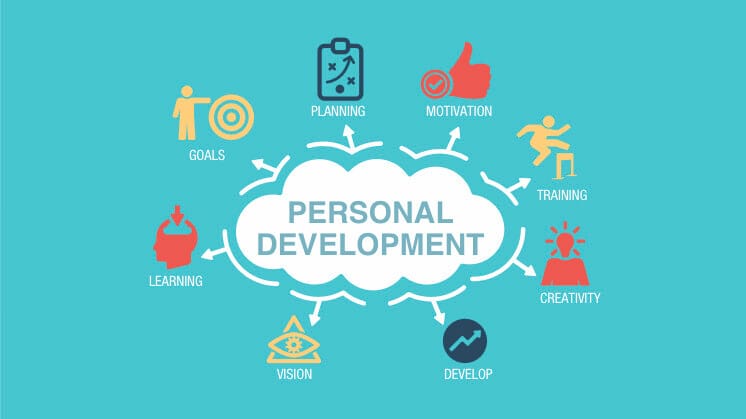Personal Development: How Training Fuels Professional Growth

Initiatives for training and personal development are educational activities carried out within an organization to improve an individual’s or a group’s performance on the job. The majority of these programs focus on improving a worker’s knowledge and skill sets as well as encouraging more drive to improve work performance.
The long-term growth of employees might be the purpose of training programs that are developed independently or with the aid of a learning administration system. Orientations, classroom lectures, case studies, role-playing, simulations, and computer-based training, including e-learning, are all common training techniques.
Most employee training and development initiatives are driven by an organization’s HRD department, often known as human resource development (HRD). These initiatives can be divided into two categories of programs:
Employee Training and Personal Development
Most employee training and development initiatives are driven by an organization’s HRD department, often known as human resource development (HRD). These initiatives can be divided into two categories of programs:
Management Training and Personal Development
The process of developing certain information, skills, and talents through time to develop managers into effective leaders and managers into managers.
Why is training and development important?
Successful companies are aware that developing current staff is more advantageous and cheaper than looking for fresh talent.
The following are the top ten advantages of staff training and development programs:
- Increased productivity: Employees can boost their overall output by keeping up with new processes and technologies.
- Reduced micromanagement: Workers tend to need less supervision and work more independently when they feel empowered to complete a task.
- Train future leaders: For an organization to develop and change over time, it needs a strong pipeline of educated and creative potential leaders.
- Increased job satisfaction and retention: Employee retention increases as a result of well-trained staff members’ greater confidence and increased job satisfaction.
- Attract highly skilled employees: Top candidates are attracted to companies with a clear career path built on ongoing training and development.
- Increased consistency: Tasks are carried out consistently when training is well-organized, leading to strict quality control that end users can rely on.
- Increased camaraderie: Teamwork and collaboration are promoted by training and growth.
- Bolstered safety: Employees who receive ongoing training and development are more likely to have the information and abilities needed to do a task correctly.
- Ability to cross-train: Employees that receive regular training become knowledgeable team members who may support or teach one another as needed.
- Added innovation: Employees that receive regular training can assist in creating creative ideas and goods, which will improve the business’s bottom line and long-term profitability.
Current trends in training and development
Businesses must be adaptable and agile because the corporate market is always evolving. One of the main forces behind this quick transformation is technology, with automation and artificial intelligence (AI) at the forefront.
The following four major trends will force organizations to reconsider their training and development strategies:
Remote mobile Training
Corporations today have realized that performance is now influenced by when, where, and how development experiences are used rather than just what employees need to know. Companies are depending more on mobile workforces as a result of advances in mobile technologies. Mobile apps offer “just-in-time” advice and information to workers across industries as training migrates to these devices.
AI Training
Artificial intelligence (AI) systems can process unstructured data similarly to humans. These systems are capable of comprehending spoken language as well as auditory, visual, and textual objects. AI-based software may recommend content based on a learner’s past performance, customize how training content is provided to a learner depending on their learning preferences, and forecast what information is most important for them to learn next.
Agile Learning
Employees are encouraged to experiment usually and learn by doing as part of the agile learning process, which promotes organizational change and buy-in. For instance, IBM has unveiled IBM Garage, a platform for carrying out, expanding, and managing a company’s various transformation activities. IBM Garages are being used globally by organizations like Ford Motor Company and Travelport to encourage cultures of open collaboration and ongoing learning.
Remote flexible learning models
Although distance learning has been around for a while, the COVID-19 pandemic has brought attention to how important it is for businesses to have robust, adaptable, and mobile workforce management. Organizations have realized the importance of being productive, engaged, and always learning and improving remote workforces.
Training and Personal Development Challenges
Many corporate training programs may not be very effective, according to recent papers and business surveys. Learners won’t retain most training completely. Using targeted distance learning programs and mobile “just-in-time” training, businesses must foster a culture of continuing, self-directed, and self-motivated learning.
Organizations must also reconsider the bigger picture of the talents that will be required shortly. In the next three years, more than 120 million workers in the world’s twelve top economies may need to undergo retraining due to AI-enabled automation, according to a recent meta-level IBM study (PDF, 916 KB).
A few outcomes from the study are as follows:
- Skilled humans fuel the global economy: Digital literacy is still important, but soft skills are also more significant.
- Skills availability and quality are in jeopardy: Organizations are under pressure to discover strategies to remain ahead of skills relevancy as the half-life of skills continues to shorten and the time it takes to close a skills gap has increased.
- Intelligent automation is an economic game changer: Millions of people will probably need to undergo retraining and pick up new skills, but most businesses and nations are ready for the challenge.
- Organizational cultures are shifting: A new business model, new ways of working, and a flexible culture are now required in the digital age to support the growth of important new skills.
The study comes to the conclusion that alternative techniques and tactics can significantly impact the skills gap closure and that traditional recruiting and training are no longer as successful. Several approaches and techniques include:
- Make it personal: Make career, skills, and learning development opportunities specifically customized for the interests and goals of your staff.
- Improve transparency: Put skills at the center of your training strategy and strive for deep visibility into your organization’s standing on skills.
- Look inside and out: Adopt an open technological architecture and a group of partners that can benefit from the most recent advances.
Here at CourseMonster, we know how hard it may be to find the right time and funds for training. We provide effective training programs that enable you to select the training option that best meets the demands of your company.
For more information, please get in touch with one of our course advisers today or contact us at training@coursemonster.com




Comments ()